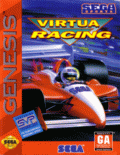
































Virtua Racing

Virtua Racing or V.R. for short, is a Formula One racing arcade game, developed by Sega AM2 and released in 1992. Virtua Racing was initially a proof-of-concept application for exercising a new 3D-graphics platform under development, the 'Model 1'. The results were so encouraging, that Virtua Racing was fully developed into a standalone arcade title. Though its use of 3D polygonal graphics was predated by arcade rivals Namco (Winning Run in 1988) and Atari (Hard Drivin' in 1989), Virtua Racing had vastly improved visuals in terms of polygon count, frame rate, and overall scene complexity, and displayed multiple camera angles and 3D human non-player characters, which all contributed to a greater sense of immersion. Virtua Racing is regarded as one of the most influential video games of all time, for laying the foundations for subsequent 3D racing games and for popularizing 3D polygonal graphics among a wider audience.
The original arcade game has three levels, designated into difficulties. Beginner is 'Big Forest', intermediate is 'Bay Bridge' and expert is 'Acropolis'. Each level has its own special feature, for example the amusement park in 'Big Forest', or the 'Bay Bridge' itself, or the tight hairpin of 'Acropolis'.
When selecting a car, the player can choose different transmission types. VR introduced the 'V.R. View System' by allowing the player to choose one of four views to play the game. This feature was then used in most other Sega arcade racing games (and is mentioned as a feature in the attract mode of games such as Daytona USA). It was later ported to home consoles, starting with the Mega Drive/Genesis in 1994.
V.R. was released in a 'twin' cabinet – the standard and most common version, which is effectively 2 complete machines built into a single cabinet. The Twin cabinets for the U.S. were manufactured by contract at Grand Products, Inc. in Illinois for Sega and were built using Wells-Gardner 25' monitors, nearly all of which had Zenith picture tubes with a manufacturing defect that caused them to fail after a few years of use. As a result of this, many V.R. machines were parted or thrown out and are an uncommon sight today. The Twin cabinet that was sold in the rest of the world was built by Sega in Japan and used 29' Nanao monitors.
Also available was an upright (UR), which was a single-player cabinet using the same force-feedback steering as the twin.
There was also a Deluxe version, known as the V.R. DX cabinet type, which is also a single-player machine and has a 16:9 aspect-ratio Hantarex monitor (the first use of a widescreen aspect ratio monitor in an arcade game), and 6 airbags (3 on each side) built into the seat that will inflate and 'nudge' the player when cornering, and one more airbag on the player's back that inflates under braking. The seat is also adjustable via 'forward' and 'back' buttons using air pressure. V.R. DX's force-feedback steering also uses two pneumatic cylinders to rotate the steering wheel, which differ from the electric motor-and-clutch system that the upright and twin versions use (which have no inbuilt air system), so the steering feel is quite different.
Virtua Formula was released in 1993. It was unveiled at the opening of Sega's second arcade amusement park Joypolis, where a whole room with 32 machines was dedicated to the game. Virtua Formula was effectively a 'super DX' version of V.R. and the player sat in a full-motion hydraulically actuated Formula One car 'replica' in front of a 50-inch screen. Most of these units were converted into Sega's second-generation Indy car simulator, Indy 500, and are commonly found at larger Sega Gameworks locations in the U.S.
All versions of Virtua Racing are linkable up to 8-players; meaning 4 twin units or 8 DX, UR, or Virtua Formula cabinets can be linked together using fiber-optic cables. In addition to this, there was an optional display known as the Live Monitor that would sit atop the twin cabinets and replay action shots of what was occurring with actual players in a 'virtual sportscast' by a virtual commentator, 'Virt McPolygon'. There is only one track.
Due to the complexity of the Model 1 board, a home console version seemed unlikely, until 1994 when a cartridge design incorporating the Sega Virtua Processor (SVP) on an extra chip was created to enable a version on the Genesis/Mega Drive. This chip was extremely expensive to manufacture, leading Sega to price the Genesis version of Virtua Racing unusually high: US$100 in the United States and £70 in the United Kingdom.
The game renders 9,000 polygons per second with the SVP chip, significantly higher than what the standard Genesis/Mega Drive hardware is capable of. The game was incompatible with Majesco Entertainment's re-released Genesis 3 from 1998, and would not work on any Genesis equipped with a Sega 32X.
How to play:
Click on the joystick icon in the Virtua Racing online emulator to see how to control the Virtua Racing game









































Comments